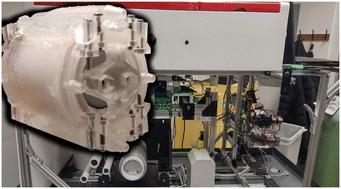Our official English website, www.x-mol.net, welcomes your
feedback! (Note: you will need to create a separate account there.)
Roll-to-roll manufacturing of large surface area PDMS devices, and application to a microfluidic artificial lung
Lab on a Chip ( IF 6.1 ) Pub Date : 2024-07-24 , DOI: 10.1039/d4lc00339j Andrew Zhang 1, 2 , Kartik Tharwani 1 , Jennifer Wang 1 , Gabriele K Seilo 1 , Michael A Atie 1, 2 , Joseph A Potkay 1, 2
Lab on a Chip ( IF 6.1 ) Pub Date : 2024-07-24 , DOI: 10.1039/d4lc00339j Andrew Zhang 1, 2 , Kartik Tharwani 1 , Jennifer Wang 1 , Gabriele K Seilo 1 , Michael A Atie 1, 2 , Joseph A Potkay 1, 2
Affiliation

|
The ability to cost-effectively produce large surface area microfluidic devices would bring many small-scale technologies such as microfluidic artificial lungs (μALs) from the realm of research to clinical and commercial applications. However, efforts to scale up these devices, such as by stacking multiple flat μALs have been labor intensive and resulted in bulky devices. Here, we report an automated manufacturing system, and a series of cylindrical multi-layer lungs manufactured with the system and tested for fluidic fidelity and function. A roll-to-roll (R2R) system to engrave multiple-layer devices was assembled. Unlike typical applications of R2R, the rolling process is synchronized to achieve consistent radial positioning. This allows the fluidics in the final device to be accessed without being unwrapped. To demonstrate the capabilities of the R2R manufacturing system, this method was used to manufacture multi-layer μALs. Gas and blood are engraved in alternating layers and routed orthogonally to each other. The proximity of gas and blood separated by gas permeable PDMS permits CO2 and O2 exchange via diffusion. After manufacturing, they were evaluated using water for pressure drop and CO2 gas exchange. The best performing device was tested with fresh whole bovine blood for O2 exchange. Three μALs were successfully manufactured and passed leak testing. The top performing device had 15 alternating blood and gas layers. It oxygenated blood from 70% saturation to 95% saturation at a blood flow of 3 mL min−1 and blood side pressure drop of 234 mmHg. This new roll-to-roll manufacturing system is suitable for the automated construction of multi-layer microfluidic devices that are difficult to manufacture by conventional means. With some upgrades and improvements, this technology should allow for the automatic creation of large surface area microfluidic devices that can be employed for various applications including large-scale membrane gas exchange such as clinical-scale microfluidic artificial lungs.
中文翻译:

大表面积PDMS装置的卷对卷制造及其在微流控人工肺中的应用
经济高效地生产大表面积微流体装置的能力将使许多小型技术(例如微流体人工肺(μAL))从研究领域走向临床和商业应用。然而,扩大这些设备规模的努力(例如通过堆叠多个扁平μAL)是劳动密集型的,并导致设备体积庞大。在这里,我们报告了一个自动化制造系统,以及一系列用该系统制造的圆柱形多层肺,并测试了流体保真度和功能。组装了用于雕刻多层器件的卷对卷 (R2R) 系统。与 R2R 的典型应用不同,滚压过程是同步的,以实现一致的径向定位。这允许在不打开包装的情况下访问最终设备中的流体。为了展示 R2R 制造系统的功能,该方法用于制造多层 μAL。气体和血液被雕刻在交替的层中,并且彼此正交。气体和血液通过透气的PDMS 分开,使得CO 2和O 2通过扩散进行交换。制造后,使用水对其压降和CO 2气体交换进行评估。性能最佳的装置使用新鲜的全牛血进行 O 2交换测试。三个 μAL 已成功制造并通过泄漏测试。性能最好的设备有 15 个交替的血液层和气体层。其在3 mL min -1的血流量和234 mmHg的血液侧压降下将血液从70%饱和度充氧至95%饱和度。 这种新型卷对卷制造系统适用于传统方法难以制造的多层微流体装置的自动化构建。通过一些升级和改进,该技术应该能够自动创建大表面积微流体装置,该装置可用于各种应用,包括大规模膜气体交换,例如临床规模微流体人工肺。
更新日期:2024-07-24
中文翻译:

大表面积PDMS装置的卷对卷制造及其在微流控人工肺中的应用
经济高效地生产大表面积微流体装置的能力将使许多小型技术(例如微流体人工肺(μAL))从研究领域走向临床和商业应用。然而,扩大这些设备规模的努力(例如通过堆叠多个扁平μAL)是劳动密集型的,并导致设备体积庞大。在这里,我们报告了一个自动化制造系统,以及一系列用该系统制造的圆柱形多层肺,并测试了流体保真度和功能。组装了用于雕刻多层器件的卷对卷 (R2R) 系统。与 R2R 的典型应用不同,滚压过程是同步的,以实现一致的径向定位。这允许在不打开包装的情况下访问最终设备中的流体。为了展示 R2R 制造系统的功能,该方法用于制造多层 μAL。气体和血液被雕刻在交替的层中,并且彼此正交。气体和血液通过透气的PDMS 分开,使得CO 2和O 2通过扩散进行交换。制造后,使用水对其压降和CO 2气体交换进行评估。性能最佳的装置使用新鲜的全牛血进行 O 2交换测试。三个 μAL 已成功制造并通过泄漏测试。性能最好的设备有 15 个交替的血液层和气体层。其在3 mL min -1的血流量和234 mmHg的血液侧压降下将血液从70%饱和度充氧至95%饱和度。 这种新型卷对卷制造系统适用于传统方法难以制造的多层微流体装置的自动化构建。通过一些升级和改进,该技术应该能够自动创建大表面积微流体装置,该装置可用于各种应用,包括大规模膜气体交换,例如临床规模微流体人工肺。

















































 京公网安备 11010802027423号
京公网安备 11010802027423号